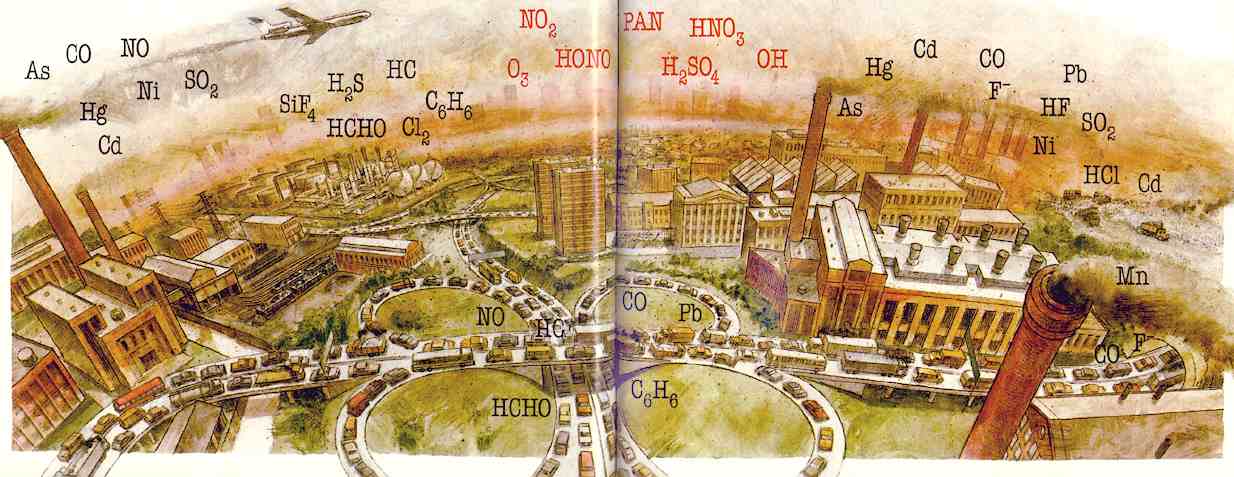previous page
next page
A deadly soup
RARELY does a city suffer from just a few air pollutants.
Most, like this symbolic U.S. metropolis (below), generate a complex brew.
Some chemicals (black labels) are emitted directly from identifiable sources.
Others (red labels) are formed indirectly through photochemical reactions
in the air. A glossary of major pollutants follows.

-
As (arsenic) from coal and oil furnaces,
glass manufacturing; long-term. exposure may cause lung and skin cancer.
-
C6H6(benzene) From refineries, motor
vehicles; long-term exposure may cause leukemia.
-
Cd (cadmium) from smelters, burning
waste, coal and oil furnaces; long-term exposure damages kidneys and lungs,
weakens bones.
-
Cl2 (chlorine) from chemical industries;
forms HCl; irrates mucous membranes.
-
CO (carbon monoxide) from motor vehicles,
coal and oil furnaces, smelters, steel plants; starves body of oxygen;
damages heart.
-
F- (fluoride ion) from smelters, steel
plants; high concentrations mottle children's teeth.
-
HC (hydrocarbons) From unburned gasoline
vapors; combine with nitrogen oxides in sunlight to form smog.
-
HCHO (formaldehyde) from motor vehicles,
chemicalplants; irritates eyes, nose.
-
HCl (hydrogen chloride) from incinerators;
irritates eyes, lungs.
-
HF (hydrogen fluoride) from fertiliser
plants, smelters; irritates skin, eyes, mucous membranes.
-
Hg (mercury) from coal and oil furnaces,
smelters; causes tremors, behavioral problems.
-
HNO3 (nitric acid) formed from NO2;
a major component of acid rain; causes respiratory diseases.
-
HONO (nitrous acid) formed from NO2
and water vapor; causes respiratory ailments.
-
H2S (hydrogen sulfide) from refineries,
sewage treatment, pulp mills; causes nausea, irritates eyes.
-
H2SO4 (sulfuric acid) formed in sunlight
from sulfur dioxide and hydroxyl ions; causes respiratory ailments.
-
Mn (manganese) from steel plants, power
plants; long-term exposure may contribute to Parkinson's disease.
-
Ni (nickel) From smelters, coal and
oil furnaces; high exposure may cause lung cancer.
-
NO (nitric oxide) from motor vehicles,
coal and oil furnaces; readily oxidises to NO2.
-
NO2 (nitrogen dioxide) formed in sunlight
from NO; produces ozone; causes bronchitis, lowers resistance to influenza.
-
O3 (ozone) formed in sunlight from
nitrogen oxides and hydrocarbons; irritates eyes, aggravates asthma.
-
OH (hydroxyl radical) formed in sunlight
from hydrocarbons and nitrogen oxides; reacts with other gases to form
acid droplets.
-
PAN (peroxyacetyl nitrate) formed in
sunlight from nitrogen oxides and hydrocarbons; irritates eyes, aggravates
asthma.
-
Pb (lead) from motor vehicles, smelters;
causes brain damage, high blood pressure, impairs growth.
-
SiF4 (silicon tetrafluoride) from chemical
plants; irritates lungs.
-
SO2 (sulfur dioxide) from coal and
oil furnaces, smelters; obstructs breathing, irritates eyes.
Fear of fallout from Chernobyl caused Warsaw citizens
to post this playground off-limits. The city is only 400 miles from the
Soviet power plant where a nuclear reactor exploded on April 26, 1986,
but Polish officials were not told of the accident for more than two days.
By then a radioactive cloud had drifted over Poland, Finland, and Sweden.
Restrictions were later put on water, milk, meat, and vegetables in 25
countries.

Perhaps the most controversial environmental issue of the decade is
acid rain, but that too is clouded in mystery. Anne LaBastille
wrote "Acid Rain-How Great a Menace?" for the Nov1981 GEOGRAPHIC.
"We are in the infancy of understanding the full effects on an atmosphere
acidified by burning fossil fuels," Dr. Chris Bernabo, an air-qualityexpert,
told me. "In order to really understand it, we must conduct years of research."
The federal Clean Air Act of 1970, amended in 1977, expired in 1981.
As of this writing it continues on extensions, outdistanced by the growing
knowledge about air pollution.
We live on a forgiving planet, with mechanisms to deal with natural
pollutants. Decay, sea spray, and volcanic eruptions annually release more
sulfur than all the power plants, smelters, and other industries in the
world. Lightning bolts create nitrogen oxides just as automobiles and industrial
furnaces do, and trees emit hydrocarbons called terpenes. Their release
triggers a bluish haze that gave the Blue Ridge its name.
For millions of years the ingredients of such substances have been cycling
through the ecosystem, constantly changing form. They pass through plant
and animal tissues, sink into the sea, return to the earth, and are vaulted
aloft in some geologic event to begin the cycle again. An atom of oxygen
completes the cycle approximately once every 2,000 years. A portion of
the next breath you take could have last been breathed by Jesus.
next page


